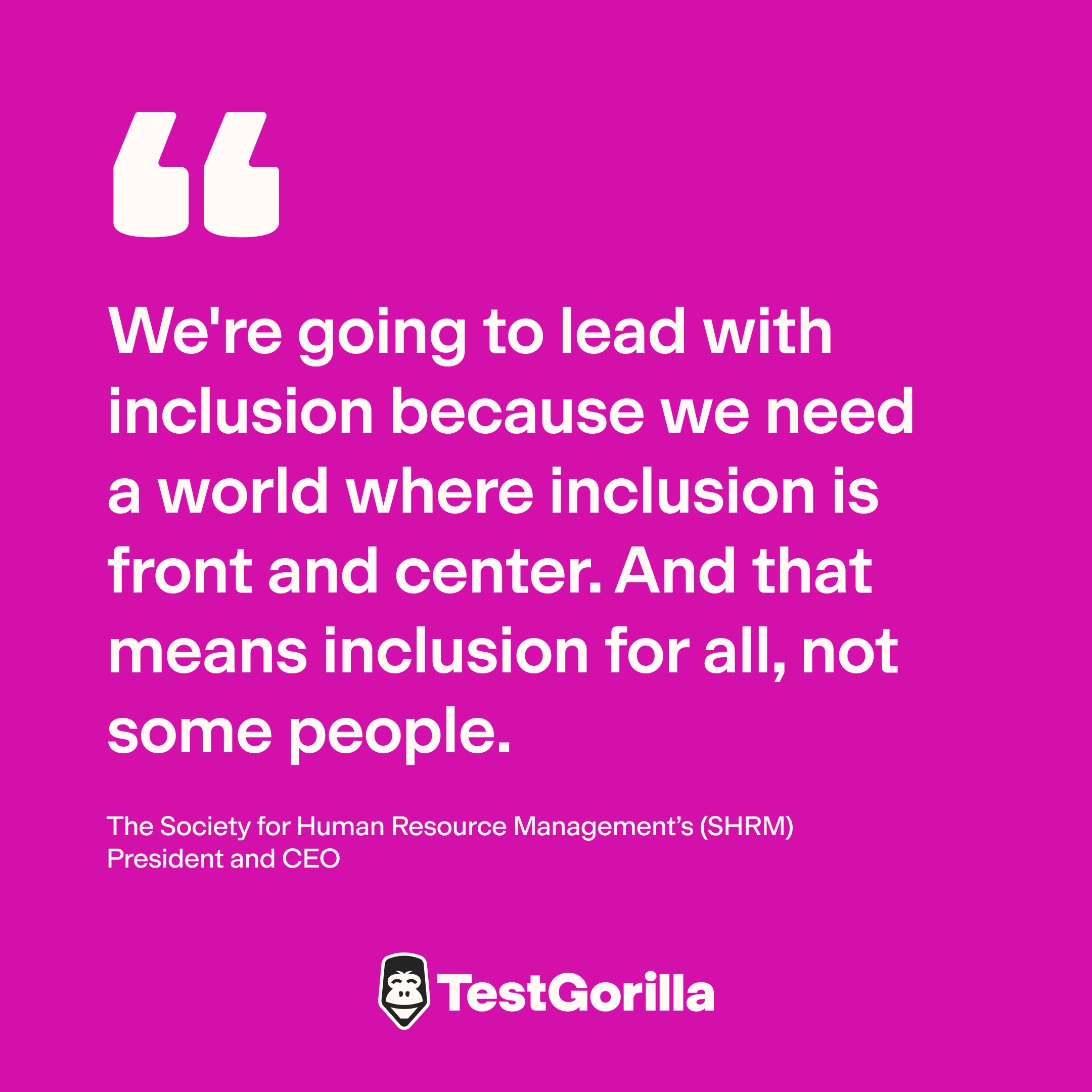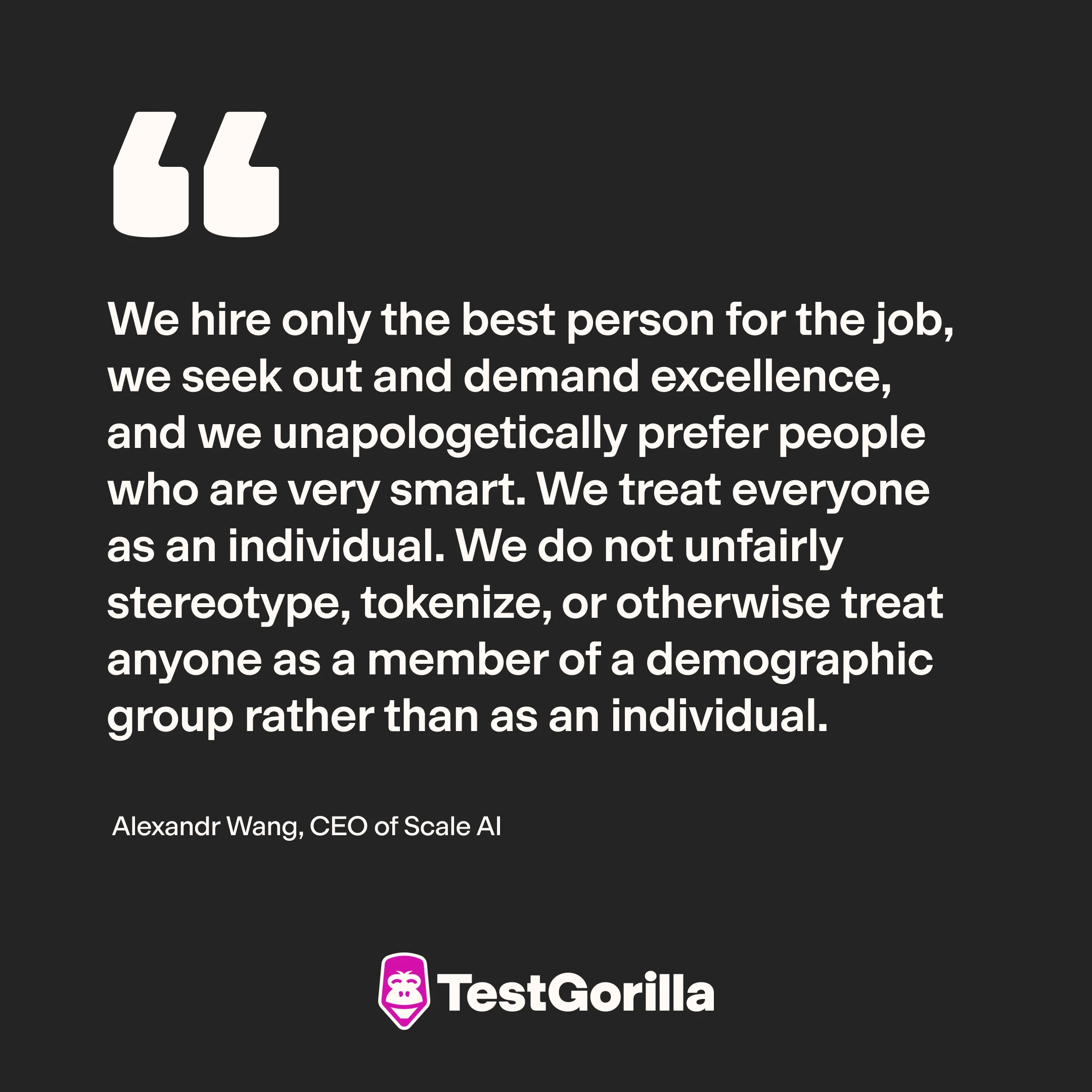Why did the world's largest HR association drop the E from DE&I?
This month, a 250-word LinkedIn statement announced that the world’s largest human resources organization is removing “equity” from its “diversity, equity, and inclusion” framework.[1]
The Society for Human Resource Management’s (SHRM) President and CEO explained the organization would instead prioritize an inclusion-first (I&D) approach: “We're going to lead with inclusion because we need a world where inclusion is front and center. And that means inclusion for all, not some people.”
The backlash was swift and overwhelming, with HR professionals labeling the decision disappointing, backward, and disturbing.
“Inclusion has always been about including everyone…and if it’s not happening, there’s an issue in execution - not acronyms,” a DE&I program and talent leader wrote on LinkedIn. A management consultant described the move as “completely out of touch,” noting “an organization that espouses ‘creating a world of work that works for all’ should be focused more than ever on equity.”
Our take? This is a short-sighted and misguided decision by an organization that sets the tone for the HR profession. Equity is essential. After all, you can’t have diversity and inclusion without it.
Table of contents
What happened?
The Society for Human Resource Management (SHRM) describes itself as the world’s largest HR association, with close to 340,000 members in 180 countries. The organization provides HR training, education, and certification and also lobbies Congress on issues relevant to its members.
On July 11, 2024, SHRM announced on LinkedIn that it is removing “equity” from its diversity, equity, and inclusion (DE&I) framework. Transitioning from the rearranged acronym IE&D (more on this in a moment), the organization would now simply use “I&D” for inclusion and diversity.
SHRM’s reasoning
SHRM explained that its inclusion-first approach aims “to address the current shortcomings of DE&I programs, which have led to societal backlash and increasing polarization,” ecouraging other employers to adopt a similar I&D framework.
SHRM elaborated in the comments of its announcement post, “Our research with countless business leaders and enterprises across the globe demonstrates the importance of emphasizing intentional Inclusion and Diversity.” To date, SHRM hasn’t revealed any further details of this research.
The organization is also concerned about the lack of consensus and misunderstandings surrounding the meaning of “equity,” which it believes can undermine workplace inclusion. Speaking to Bloomberg, SHRM CEO and President Johnny Taylor Jr. said, “There’s no common agreement about what [equity] means.”
What led to this change?
SHRM’s announcement doesn’t exist in a vacuum. It reflects a broader political, legal, and cultural shift where people are reevaluating diversity and inclusion in the workplace.
Federal and state governments
In recent years, conservative governments have criticized and tried to legislate against DE&I policies and programs in the context of education and employment.
Former President Trump vocally criticized DE&I initiatives while in office. In September 2020, Trump issued an executive order that barred federal agencies and federal government contractors from delivering specific types of DE&I training. President Biden rescinded this “Equity Gag Order” when he took office in January 2021, signaling strong support for DE&I efforts.
During this year’s campaign, Former President Trump has said, “Every institution in America is under attack from this Marxist concept of ‘equity,’” and, “If you look right now, there’s absolutely a bias against white [people], and that’s a problem.”
There are also concerns for the future of DE&I relating to Project 2025, a plan by conservative think tank the Heritage Foundation that outlines potential key policies for a new Republican government. The plan proposes removing all DE&I programs in the federal government sector and related terms from all federal rules and regulations, including DE&I, sexual orientation and gender identity, and gender equity.
While Former President Trump has denied any knowledge of or intention to rely on Project 2025, he has publicly committed to reinstate his executive order and “eradicate any attempt to weaken America’s institutions through these harmful and discriminatory ‘equity’ programs.”
Some state governments are mirroring these sentiments.
For example, in May 2023, Florida Governor Ron DeSantis signed a bill that banned public colleges and universities from using public funds to deliver DE&I programs. At the time, Governor DeSantis said, “DE&I is better viewed as standing for ‘discrimination, exclusion and indoctrination.’”
Alabama and Texas have passed similar laws, with more in the works in other states. Additionally, in Montana, Senate Bill 222 aims to prohibit the use of diversity training in the hiring process for state agencies.
Supreme Court decision
In June 2023, the US Supreme Court issued a decision that effectively ended affirmative action in university admission programs. In a case against Harvard and the University of North Carolina, the court held that the universities’ use of race as a factor in their admissions processes violated the Equal Protection Clause of the Fourteenth Amendment and Title VI of the Civil Rights Act.
Following the decision, corporate America voiced concern about its potential impact on workplace DE&I policies and programs. While the decision doesn’t apply directly to employers – the Equal Protection Clause applies only to public institutions and the relevant Title VII provisions to bodies that receive federal financial aid – it prompted many employers to review their approach to DE&I amid fears of legal challenges.
These fears weren’t unfounded, as various lawsuits targeting workplace DE&I initiatives have since been filed against employers.
Conservative advocacy groups America First Legal (AFL) and the American Alliance for Equal Rights have initiated several of these. In a current case against Red Hat Inc., AFL alleges the company’s diversity targets resulted in the termination of a white male employee.
AFL has also filed complaints with the Equal Employment and Opportunity Commission (EEOC) against dozens of companies, including Nike and Mattel, alleging their diversity targets are illegal and discriminatory.
Private-sector business leaders
Anti-DE&I sentiments are also gaining traction in the private sector.
Elon Musk, CEO of Tesla, made his position clear on the platform X. “DE&I must DIE,” he wrote. Instead, Musk supports MEI: merit, excellence, and intelligence. Alexandr Wang, CEO of Scale AI and the person to coin the phrase, explains its rationale:
In the wake of George Floyd’s murder and the Black Lives Matter movement in 2020, corporate America responded with passionate pledges and renewed enthusiasm to support workplace DE&I. Several years later, however, reports suggest there’s a quiet but widespread trend of reducing DE&I roles and programs, especially in the tech sector.
A recent study by Revelio Labs, which analyzed data from over 600 US companies, found that between January 2020 and January 2023, DE&I roles are leaving companies at a rate twice that of non-DE&I roles.
Employee sentiments
With political tides and employer sentiments shifting, how do employees feel about DE&I in the workplace?
Researching the issue last year, Pew collected responses from 4,744 US workers. 56% said a focus on workplace DE&I is mainly a good thing, and 54% feel their employer pays the right level of attention to increasing DE&I.
There was a clear split along political lines, with 78% of Democratic and Democratic-leaning workers saying focusing on DE&I at work is good compared to just 30% of Republicans and Republican leaners.
Our take at TestGorilla
We acknowledge that SHRM represents a broad and diverse group of members with equally diverse views, which is no easy task.
However, the organization’s decision to remove the E from DE&I is fundamentally flawed.
Inclusion can’t exist without equity
We believe SHRM’s position is illogical. DE&I is the long-used acronym for a reason: Each concept relies on the others, and you can’t have inclusion and diversity without equity.
Diversity involves bringing different people to the table, ensuring a representative mix of perspectives and experiences. Equity refers to the processes that ensure everyone receives access to the table and fair treatment once they’re there. Inclusion is about creating an environment at the table where everyone feels welcome, respected, and valued.
Dayna Cleland, Customer Success Advisor at TestGorilla, explains:
This decision from SHRM ignores the fact that DE&I was written in that way for a reason: Each step is a prerequisite to the next. By deemphasizing equity, how do you get to inclusion? How can you feel included if you aren't paid equally? To me, that is the biggest concern.
While diversity and inclusion are goals, equity is about the practical steps organizations must take to achieve them. Without the E in DE&I, efforts to create a diverse and inclusive environment may fall short, leading to diversity washing. Only by addressing systemic barriers can true inclusion and representation be achieved.
SHRM’s position is contradictory
SHRM’s explanation for the change cites difficulties with the concept of “equity,” including the lack of consensus on its definition and backlash against DE&I programs.
But in the same breath, the organization says, “Our commitment to advancing Equity remains steadfast. Equity will be integrated under the broader Inclusion framework, continuing to be a priority in our strategy and leadership decisions.”
So, while SHRM claims that negative statements and the challenges of defining equity justify its removal from DE&I, the organization will continue to prioritize equity within its inclusion framework. Confused? You’re not alone.
We also disagree with SHRM’s comments on the difficulties of defining equity. For us, it’s always been crystal clear.
Equity is the process of recognizing inequality and making adjustments to overcome prejudice (including systemic bias) and its effects. It acknowledges that not everyone starts with the same privileges and encourages organizations to take steps to level the playing field.
Equity differs from but supports the concept of equality, where each individual is equal, especially regarding opportunities, status, and rights. An oft-used metaphor for equity vs. equality is giving everyone a pair of shoes (equality) vs. giving everyone a pair of shoes in their specific size (equity).
Equity helps us achieve true equality. As Romina da Costa, TestGorilla’s Director of IP Development, emphasizes:
Equity is different from equality in that it recognizes that each individual comes from different circumstances. Equity is about leveling the playing field by addressing disparities and systemic barriers. Can you really have diversity and inclusion without promoting equity?
SHRM’s position undermines the strong business case for DE&I
Experience has shown that DE&I practices benefit both employees and employers.
These benefits include:
Better financial performance. McKinsey's research on over 1,000 companies found that ethnically and gender-diverse teams are 36% and 25% more likely to financially outperform less diverse teams.
Increased innovation and creativity. In a Forbes survey of 321 executives, 85% agreed that having a diverse and inclusive workforce is essential for promoting different perspectives and ideas that fuel innovation.
Improved employee retention. DE&I is a key influencer of employee engagement and, as a result, their decision to stay with a company. A 2022 GoodHire survey of 3,000 US workers found that 81% would consider leaving their jobs if their employer failed to demonstrate a commitment to workplace DE&I.
Equity has been a cornerstone of workplace DE&I initiatives since the 1960s. By shifting focus from it, organizations may erode the effectiveness of their DE&I efforts, missing out on these benefits.
SHRM’s change highlights the importance of skills over certifications
We also wonder about the impact of this move on the credibility of SHRM’s certifications. Many HR professionals disagree with the change, and some are considering withdrawing their membership or not participating in SHRM training or certifications.
It’s easy to understand why people feel this way. Why invest in certifications from an institution that doesn’t align with their values and contradicts what many have spent significant parts of their careers working on?
However, as TestGorilla’s Dayna Cleland notes, SHRM is an organization “many companies have deemed necessary for certification before taking a candidate seriously.”
For us, this underscores the importance of a skills-first approach to hiring. Qualifications and certifications may be missing from an applicant’s resume for a valid reason. By looking beyond these and focusing on candidates’ actual skills using tools like pre-employment assessments, you can hire the best person for the job regardless of credentials.
TestGorilla keeps the E in DE&I
By dropping “equity” from its DE&I framework, SHRM has sparked outrage and highlighted a critical flaw in its approach. DE&I is more than just an initialism. Without equity, diversity and inclusion are mere buzzwords, failing to address systemic barriers and real disparities in the workplace.
SHRM’s move undermines progress and sends the wrong message to employers. True inclusion demands equity. It’s not just about being diverse but ensuring everyone has a fair chance to thrive.
At TestGorilla, we encourage employers to rise above the damaging political rhetoric and stay committed to promoting diversity, inclusion, and equity.
Sources
[1] Human Resource Director, SHRM removes ‘equity’ from DE&I program ‘to address flaws,’ 15 July 2024, https://www.hcamag.com/us/specialization/diversity-inclusion/shrm-removes-equity-from-dei-program-to-address-flaws/497198
Related posts
You've scrolled this far
Why not try TestGorilla for free, and see what happens when you put skills first.
Latest posts
The best advice on pre-employment testing, in your inbox.
No spam. Unsubscribe at any time.

Hire the best. No bias. No stress.
Our screening tests identify the best candidates and make your hiring decisions faster, easier, and bias-free.
Free resources
This checklist covers key features you should look for when choosing a skills testing platform
This resource will help you develop an onboarding checklist for new hires.
How to assess your candidates' attention to detail.
Learn how to get human resources certified through HRCI or SHRM.
Learn how you can improve the level of talent at your company.
Learn how CapitalT reduced hiring bias with online skills assessments.
Learn how to make the resume process more efficient and more effective.
Improve your hiring strategy with these 7 critical recruitment metrics.
Learn how Sukhi decreased time spent reviewing resumes by 83%!
Hire more efficiently with these hacks that 99% of recruiters aren't using.
Make a business case for diversity and inclusion initiatives with this data.



















